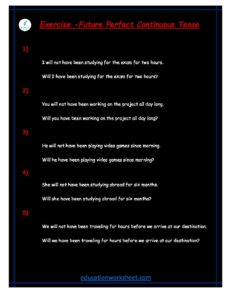Future Continuous Tense affirmative examples worksheets
Future Continuous Tense affirmative examples
Structure of the Future Continuous Tense (Affirmative)
The Future Continuous Tense is relatively easy to construct in English. It consists of the following elements:
- The modal auxiliary “will”
- The base form of the main verb (also called the bare infinitive)
- The present participle form of the main verb
The structure is as follows: [Subject] + will + be + [base form of the verb + -ing]
Let’s break down these elements:
- Subject: This is the noun or pronoun that performs the action or is the focus of the sentence. It can be in the form of “I,” “you,” “he,” “she,” “it,” “we,” “they,” or any other noun or pronoun.
- Will: This is the modal auxiliary that indicates the action will take place in the future. It is the same for all subjects.
- Base Form of the Verb: This is the simple, uninflected form of the verb. For example, the base form of the verb “run” is “run.”
- Present Participle Form of the Verb (-ing form): This is the -ing form of the verb, which indicates that the action is continuous or ongoing. For example, the present participle form of the verb “read” is “reading.”
Future Continuous Tense affirmative examples worksheets

Here are some affirmative examples to illustrate the usage of the Future Continuous Tense:
I will be studying for my final exams tomorrow evening.
- In this example, “I” is the subject, “will” is the modal auxiliary, “be” is the auxiliary indicating the continuous aspect, and “studying” is the present participle form of the main verb “study.” This sentence indicates that the action of studying will be ongoing in the future.
She will be working late tonight.
- “She” is the subject, “will” is the modal auxiliary, “be” is the auxiliary indicating the continuous aspect, and “working” is the present participle form of the main verb “work.” This sentence suggests that she will be working late into the evening.
They will be traveling to Europe next summer.
- In this case, “They” is the subject, “will” is the modal auxiliary, “be” is the auxiliary indicating the continuous aspect, and “traveling” is the present participle form of the main verb “travel.” The sentence implies that their travel to Europe will be ongoing in the future.
We will be watching a movie at the cinema on Friday night.
- “We” is the subject, “will” is the modal auxiliary, “be” is the auxiliary indicating the continuous aspect, and “watching” is the present participle form of the main verb “watch.” This sentence conveys the idea that they will be in the middle of watching a movie at the cinema on Friday night.
The construction workers will be building a new skyscraper downtown next year.
- In this example, “The construction workers” is the subject, “will” is the modal auxiliary, “be” is the auxiliary indicating the continuous aspect, and “building” is the present participle form of the main verb “build.” This sentence informs us that the construction of a new skyscraper will be underway downtown next year.
Future Continuous Tense affirmative examples worksheets

By this time next week, I will be relaxing on a beach in Hawaii.
- “I” is the subject, “will” is the modal auxiliary, “be” is the auxiliary indicating the continuous aspect, and “relaxing” is the present participle form of the main verb “relax.” This sentence paints a picture of someone enjoying some leisure time on a Hawaiian beach a week from now.
The students will be taking their final exams at this time next month.
- In this case, “The students” is the subject, “will” is the modal auxiliary, “be” is the auxiliary indicating the continuous aspect, and “taking” is the present participle form of the main verb “take.” This sentence implies that the students will be in the process of taking their final exams at the specified time next month.
By the time you arrive, we will be eating dinner.
- “We” is the subject, “will” is the modal auxiliary, “be” is the auxiliary indicating the continuous aspect, and “eating” is the present participle form of the main verb “eat.” This sentence indicates that the action of eating dinner will be in progress when the person addressed arrives.
Next week, the company will be launching its new product.
- In this example, “The company” is the subject, “will” is the modal auxiliary, “be” is the auxiliary indicating the continuous aspect, and “launching” is the present participle form of the main verb “launch.” The sentence tells us that the company’s product launch will be ongoing next week.
I will be participating in a marathon next month.
- “I” is the subject, “will” is the modal auxiliary, “be” is the auxiliary indicating the continuous aspect, and “participating” is the present participle form of the main verb “participate.” This sentence suggests that the individual will be involved in a marathon in the coming month.
Future Continuous Tense affirmative examples worksheets

These affirmative examples showcase the flexibility and versatility of the Future Continuous Tense in expressing actions or events that will be ongoing in the future. Whether it’s studying for exams, working late, traveling, watching a movie, building a skyscraper, relaxing on a beach, taking final exams, eating dinner, launching a product, or participating in a marathon, the Future Continuous Tense provides a valuable tool for conveying a sense of continuity in future actions and events. By understanding the structure and usage of this tense, you can effectively communicate your intentions and plans for the future.

